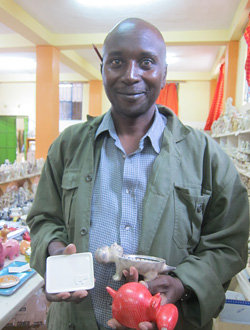#03 Interview - Soap Stone Production Leaders
In this issue, we would like to introduce the interview with the Technical Leader of soap stone production, Laurence and Stanlay.
Interview 1: Laurence (age: 52)

(Question 1)When did you start learning how to carve soap stones, and how did you master your skills?
(Laurence) I started learning how to carve when I was about 10 years old, watching and copying my father. Soap stone is a gift to our region and everyone here learns how to carve by watching and copying their father and elder brothers.
(Question 2)What do you enjoy making the most?
(Laurence) I like to make chess sets.
(Question 3)Was there anything new you learned through the MUJI project?
(Laurence) Through the MUJI project we learned the importance of making products in requested sizes. Before, our products were of all sizes, but we learned to produce products of specified sizes by keeping curtain parts within curtain measurements.
 We have account books to keep track of daily and weekly paid records.
We have account books to keep track of daily and weekly paid records.
 Soap stone sculptures are carefully carved out one by one by hand.
Soap stone sculptures are carefully carved out one by one by hand.
Laurence is a professional minded leader, and for this year's MUJI - JICA project, he headed the candle stand group. After every quality check meeting, he would go back to his team and inform any revision made.
Interview 2: Stanlay (age: 47)
 This is Stanlay, with the "Smiling Hippo" designed by himself,
This is Stanlay, with the "Smiling Hippo" designed by himself,
and this year's MUJI products.
(Question 1) When did you start carving soap stones, and how did you master your skills?
(Stanlay) I started when I was 12 years old. Both my father and grandfather worked as soap stone craftsmen and I gradually learned by watching and copying their stills.
(Question 2) What do you most enjoy doing in your work, and how do you spend your time after work and on the weekends?
I like to relax watching TV. I also like to spend time with my family. I have six children and my eldest will be 23 this year. He started working at a newspaper company after he graduated from college.
(Question 3) What do you enjoy most about your job?
(Stanlay) I think it's when I'm designing something. It is fun to see the designs come to life. The Smiling Hippo is my favorite character. 12 years ago I designed it and it has been one of the best-selling items since. I also designed a plate with the Smiling Hippo motif, and this also is a good-selling item. It is nice to see your designs been favored for a long time.
(Question 4) How was the MUJI - JICA project?
(Stanlay) Strict size restrictions and quality check are the strongest impression I have, but it was a very fulfilling experience. Last year, restrictions on shape, size and time constraints were a little strict than expected. This year we had a little more time to absorb the reasons towards the requirements, and the also the requirements itself were made simpler, which made it easier for everyone to understand. It was also good everyone took part in the kick-off meeting where the MUJI - JICA project policy was explained.
 Every piece is carefully measured to be in the required shape and size.
Every piece is carefully measured to be in the required shape and size.
 A plastic template was made, on site, to carve out the giraffe motif.
A plastic template was made, on site, to carve out the giraffe motif.
Stanlay was the leader for tray group. He developed tools to keep the trays within the same size, and templates of motifs to make carving processes easier. Whenever there any alterations were made, he would immediately go out to his group to explain the changes.
After the interview.
From the two interviews, we learned that soap stone is not only a very common item but also a precious income source for the people of Kisii.
Children grow up playing with soap stone toys, and watching their parents carve soap stone from a young age, naturally turning them into soap stone craftsmen to earn their living.
Please look forward to meeting the warm handmade items from Kisii, Kenya to arrive, any minute now, in your nearest MUJI store.
 Children playing around the soap stone workshops, with soap stone toys.
Children playing around the soap stone workshops, with soap stone toys.
 A child holding a piece of soap stone left over by the workshop.
A child holding a piece of soap stone left over by the workshop.



